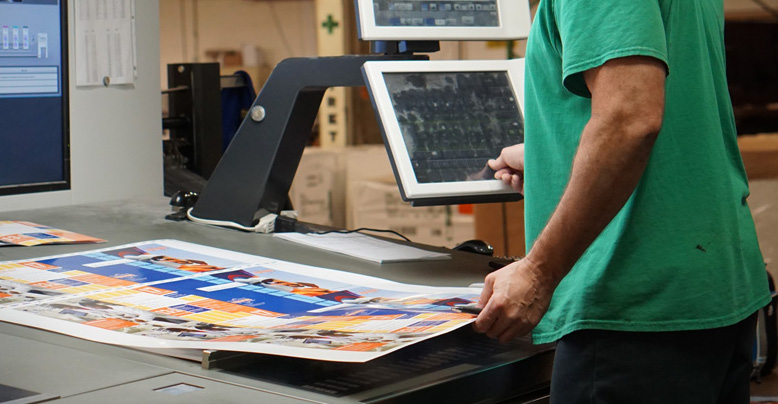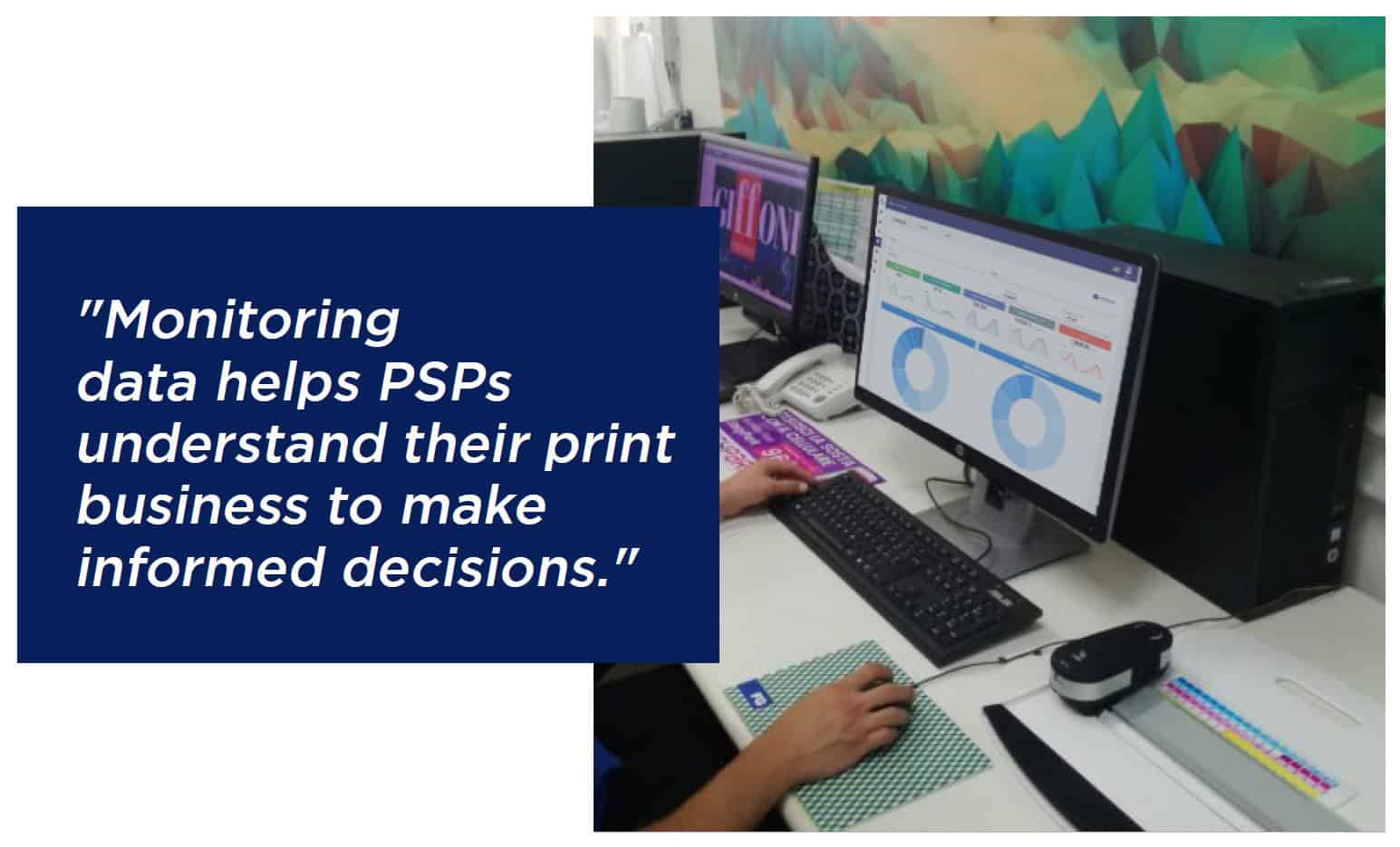Why PSPs need data to make better business decisions
by Jonthan Rogers, PhD
Introduction
Organizations from around the globe have been quick to jump on the data bandwagon to improve efficiency, reduce costs and increase sales. Over the past several years, companies specializing in big data and connectivity have focused on investment activity representing over $800Bn USD in 2020 alone(i).
Interestingly, the COVID-19 pandemic has increased this activity making data more important than ever for businesses wishing to make informed decisions. But what does that mean exactly? While investment interest places value on data or the creation of business data tools, how does data help a business? More specifically, how does data relate to the wide-format print industry? And how can Print Service Providers (PSPs) benefit from it today to make better business decisions? While one challenge of modern print businesses is gaining access to data, another is having it but not knowing what to do with it.
This article discusses recent industry trends that have given rise to the necessity for modern print businesses to be data led. In addition, we articulate the reasons why data should be gathered and measured, as well as what data to track. With the steady influx of new and useable KPIs and metrics afforded to PSPs, this article outlines some of the ways data is needed to make better business decisions.
Recent Industry Trends
Thinking about recent wide-format print industry trends it is impossible to ignore the impact the COVID-19 pandemic has had on the graphic arts industry. Print Businesses were already under pressure to be competitive and profitable in an already competitive market and COVID-19 put further pressure on already strained margins. COVID-19 has done more than just strain margins. It has sped up existing trends
such as automation and given rise to pivots in service offerings and provided an opportunity for Print Service Providers (PSPs) to look internally at business operations and efficiencies.

With many print business owners, there is a necessity to stretch further to do more with less. This has spurred the need for fast, reliable, automated, easy-to-use solutions that don’t require expert training. In fact, in a recent industry study conducted with PSPs between March 2020 and June 2021, 69% of respondents said they could improve internal efficiencies with increased automation and usable data(ii).
Taking automation first, the term automation can seem overwhelming for some as different levels of automation are required based on PSP focus and customer base. As a software vendor for wide format, the term “automation” for many of our customers is all about saving time, reducing manual error, and increasing capacity to do more with less, ultimately affecting profitability. For them, automation is paramount because it helps accomplish these goals. Some examples of this include:
- Setting up automated print workflows to reduce manual touch points
- Automating submission of jobs from a front-end ordering system such as ecommerce or web2print
- Setting up print jobs with options such as page size, rotation, step and repeat, adding tiles or finishing marks like grommets all automatically
- Applying automated color management controls to synchronize and proof color management settings across devices
- Adding cut-paths that are automatically recognized from the design software and
then barcodes to print jobs for a seamless
print and cut workflow
While the type and scale of automation a PSP implements will differ based on business size, location, and service offerings, a good first step is understanding current production problems such as bottlenecks, material wastage, manual production steps and where to manage costs. Automation software on the market today can reduce these manual touchpoints in prepress, provide data on consumable usage, and automate some finishing activities. This yields higher quality output, faster turnaround, and lower operating costs.
In terms of pivoting in this new normal, a big trend is how PSPs have been able to meet the needs of their communities. PSPs have found new ways to print, including producing safety items to assist health care workers, signage to help direct patients in hospitals, social distancing, floor graphics for several business types, and providing curbside signage for restaurants.
In addition, these new offerings have been well assimilated into a new normal rather than going away, which adds to ongoing revenue opportunities for print businesses. Lastly, speaking to internal efficiencies, a trend we have seen in the print industry these past 18 months is that PSPs have been able to capitalize on the opportunity to review, update and improve upon their current systems and processes.
For many, as they look to a post-COVID-19 year, this has included the need to upgrade their software
solutions to provide new tools and capabilities to meet their business and customer needs. So how do these trends relate to data? The idea of automation, costs savings, and looking internally to evaluable business efficiencies brings up another question: How do PSPs find out where they can improve and what to invest in? What information is available to help them identify automation tools or other solutions to enhance print and business operations? The first step in this process is to know why data is important.
Why measure data?
Perhaps less pervasive until recently in the wideformat print industry, data plays an important role in modern print businesses because it can provide measurable insight into operational performance.PSPs often ask: “Did I make money on that print job?” or “How much media did I waste?” Similarly, PSPs might ask: “Is the printer being run at capacity?” or “Am I running at capacity?” before making a new printer purchase decision. The idea that data can provide insight is not new.
The issue is while PSPs weigh on these questions regularly, many may not be implementing data into their business, using guesswork by eyeballing media waste in the trash or guessing their ink consumption. In fact, in the 2019 Wide Format Application and Utilization study by Keypoint Intelligence and Big Picture Magazine, 28% of print shops can’t quantify media savings on nested jobs because they don’t have the right tools(iii). By tracking data, however, PSPs can work out what trends are in their own business.

This could include finding out how fast one printer consumes ink compared to another, or whether the ink consumption is based on utility or printer type. It may provide insight into the level of media waste or production capacity or even help identify what products are most often purchased by customer type. Deciding on how much perforated vinyl to keep in inventory, for example, based on actual customer needs, would be helpful information to have when making media orders each month. When it comes to measuring data, there are several benefits including:
- The ability to view production performance
- Track consumption of ink and media
- Identify areas of waste
- See what products produce the highest margins
- Identify what is working and what isn’t
- Understand areas that can be improved
Tracking data saves time and resources over time but also increases productivity. This is because PSPs gain knowledge about their current organization as well as areas to improve. However, to really improve from data collection, it is important to understand what information to look for. As mentioned at the beginning of this article, one issue is not having data to use to make better business decisions, but another is not knowing what to look for or how to use it. In a study conducted by Erik Brynjolfsson, professor of information technology at Harvard University, businesses who inject data tracking and
usage become 5-6% more productive overall(iv), but it all starts with knowing what to track.
Speaking as a software vendor for wide-format print, our experience teaches us that print production data is just one facet of the kind of data that a print business can learn from to make better business decisions. Like most businesses, different data metrics and KPIs come from various sources and mean different things. Print Businesses who have launched a Web2Print shop with a new eCommerce front end, for example, are looking for different measures of performance than the efficiency of a print workflow or how fast an order can be generated from their MIS system.
In terms of web-data, research shows that businesses are making greater attempts to understand their customers through analytics data since COVID-19 than ever before. In a study conducted by Sisense, an analytics provider, 49% of small businesses are using analytics to understand their customer online interactions.

Web Data:
Taking the first in our example of online data, several metrics come to mind. This includes:
- Sessions
- Page visits
- New vs Returning Users
- Engagement
- User flow
And this is just the beginning. These don’t include other metrics such as highest product page hits or the really important one: customer conversions. However, looking at each, a PSP with a new web store as part of their website can quickly gather insight and knowledge about how visible their latest offerings are.
Sessions are the number of times people have visited the website or web store pages, with page visits telling a business owner how many people have visited that online page.
This leads into the next metric of new versus returning users where a PSP can see how many people are hitting the website for the first time and the percentage of visitors coming back a second or third time. If a new product is launched, this metric may help understand if they have new customer interest or not. Engagement is a related metric and gives an understanding of how long visitors are staying on the site. This may influence future online content if users are leaving too soon. Lastly, user flow shows the entry and exit points of users which can indicate what kind of conversion statements or pieces of information are the most useful toward a customer conversion – a sale.
Production Data:
If looking at strictly production, the data most useful to a PSP is between dropping the file into the RIP-Queue, and what comes off the printer. For this stage, metrics may include:
- Number of ripped or queued files
- Files on hold
- Failed prints
- Trends
- Job histories
- Ink consumption
- Media usage
- Media waste
Looking at each of these, they all provide important information that can help a PSP make inferences on production efficiency, performance, and production capacity. The number of ripped files could be those
currently ripping, those in the queue, or how many are ripping simultaneously. If a RIP software can RIP many files simultaneously, it implies it is sending more data to the printer in a quicker time frame, and therefore production speed is high.
If many files are on hold, why are they on hold? Is production waiting for artwork approval from a customer? Is the media being changed on a printer before these can be released? It could be that prints on hold are due to downtime and downtime is costly. If production halts for any reason, the cause of the shutdown needs to be determined as soon as possible as this can quickly impact capacity and profitability. This kind of metric helps identify if there is a possible printer problem and whether they are being used to capacity. Failed prints is an interesting metric because it implies issues with production but knowing what that issue actually is can be trickier. Let’s say a customer orders two prints of a fine art drawing 36 inches wide and 40 inches tall, and out of seven prints that made it to the printer, only two of them were usable.
If there is an available metric that counts the number of prints ordered versus the number of prints printed, a production manager can quite quickly see that the media waste in the trash is from misprinting a job that directly impacts profitability. At this point, it raises questions such as “What caused the failed print?” it might be that the media ran out before the print could finish, or there was drift in one of the color channels, making an issue with the output color before recalibrating the printer. It might mean manual error, in which case training may be the right remedy. Without such a metric, however, PSPs are blind to ways to improve. Trends are another important and interesting metric because it provides insight into which print products are most popular. For this kind of metric, industry-specific business solutions can provide insight into order and sales histories that can impact purchasing behaviors for different media and other consumables.

Similarly, if specific products are not selling, the business may either reduce these offerings or invest more heavily into marketing such products to fit with the organization’s goal of establishing itself as a leading provider of such products. Moving on, job histories provide a quick visual reference to past production for reprints and knowledge about ink consumption and media usage is invaluable in terms of providing insight into costs of operation. The last metric in our production example is media waste.Media waste represents one of the single largest challenges facing PSPs today. In an ONYX study conducted over a three-year period from PSPs across the globe, 72% said a software solution that could provide data on saving media usage and reducing waste would be an easy purchase decision.
What trends to expect:
This article has aimed to showcase that data is an important part of the assessment of print business performance with examples of just some metrics or KPIs that are part of this process. Having data, however, is not enough. It needs to be usable. Certain production metrics, for example, may infer an issue in production but may also help a PSP plan strategically toward business improvement or growth goals. It
is these kinds of inferences that help PSPs evaluate potential future software investment.
With this in mind, what kind of industry trends do we expect to see in the near future? From our experience, PSPs are already seeking out and consuming data from different sources such as RIP solutions, nesting software, business intelligence tools that provide a snapshot of shop performance, and new and interesting MIS solutions. Monitoring data of all kinds helps PSPs understand what is happening in their print business and make informed decisions from meaningful metrics. The tools PSPs use today and the tools they may use in the future are likely to change but, in our opinion, COVID-19 has increased interest in data to make better business decisions. It is an interest that won’t be going away any time soon.
Key takeaways:
- Data provides another set of eyes on business performance.
- Current industry trends include automation, and through COVID-19, internal business efficiency
- Data provides useful insight into areas needing improvement as well as aligning future goals
- Real-time, historical, and trend data require timely and appropriate actions to impact profitability
- Data metrics, usage, and application are gaining rapid interest in the print industry
– about the author –
Jonathan Rogers holds a PhD in Marketing and leads Marketing at Onyx Graphics, Inc.

sources: i: Global data 2021, available at: https://www.globaldata.com/global-ma-activity-increased-48-q1-2021-deal-value-compared-q1-2020-says-globaldata/. ii: Onyx Graphics Inc, global customer survey data 2020-2021. iii: 2019 Wide Format Application and Utilization Report, Keypoint Intelligence and Big Picture Magazine. iv: Harvard Business Review, available at https://hbr.org/2012/10/big-data-the-management-revolution. v: Sisense State of BI Analytics, available at: https://www.sisense.com/whitepapers/state-of-bi-analytics-report-2020/. vi: Onyx Graphics Inc, global customer survey data 2017-2021.
